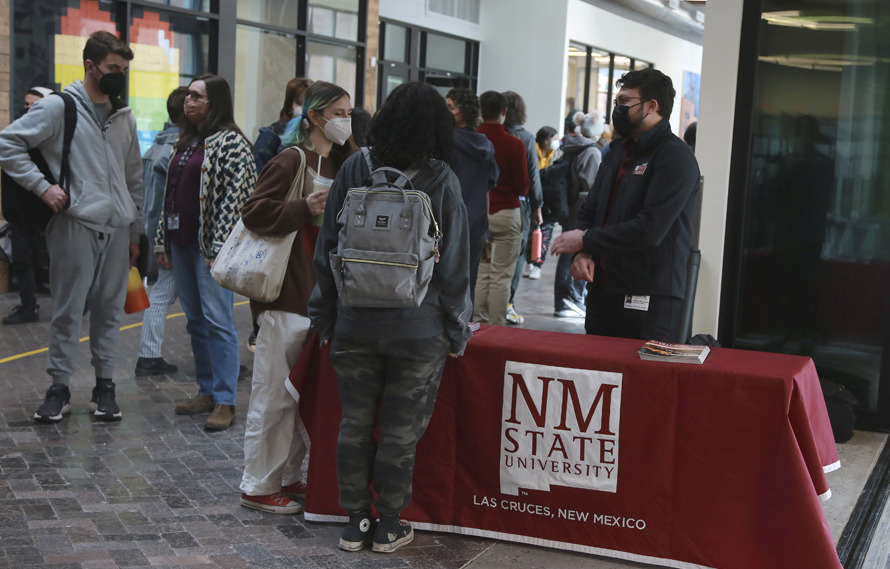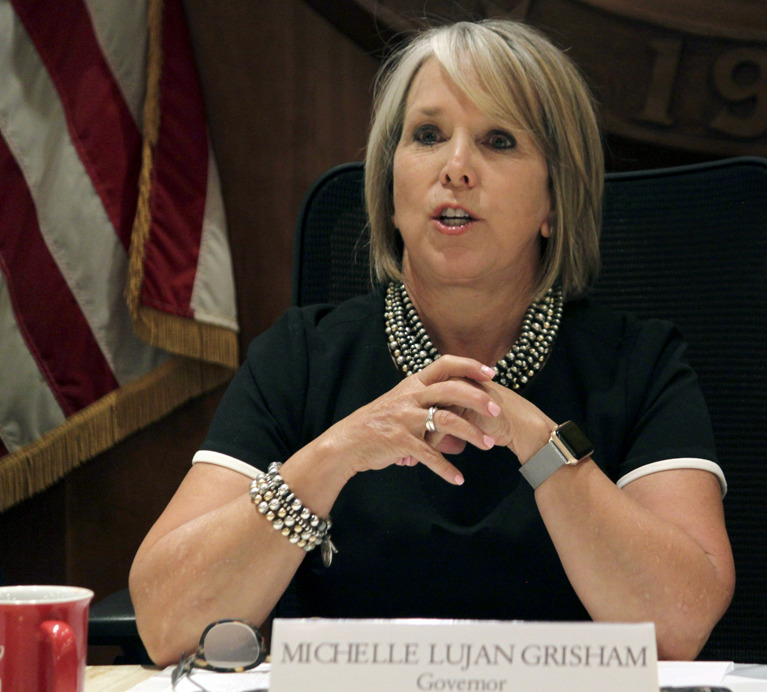SANTA FE, N.M. — Since moving to New Mexico from her home country of Malaysia in 2017, Nuraisyah A Mohd Hilmi has paused her college education twice because she couldn’t afford tuition.
She left Northern New Mexico College in Espanola, New Mexico, after one semester because as an international student she couldn’t afford another $4,800 tuition bill. She returned after getting her green card, but when Covid-19 hit and she lost her job, even the $1,500 in-state tuition was too much.
Last year, Mohd Hilmi, 23, tried again, this time at Santa Fe Community College, where four online courses cost $800. Still, for most of this school year she worked two jobs, often seven days a week — as an employee at the school’s financial aid office and as a weekend bartender — and attended online classes at night.
It’s been a stressful year — Mohd Hilmi said she once had to call in sick for a week after working 10 days in a row — but what’s gotten her through it and kept her on track to graduate by December are an array of services Santa Fe Community College provides to help students like her: computer and iPad rentals for students who can’t afford their own, reservable study spaces on campus for students whose living situations aren’t conducive to focus and the Student Emergency Assistance Fund, which helped her cover the costs of damages when her parked car was hit on campus.
“I don’t always need the help, but when I do, I know that somebody is there,” Mohd Hilmi said.
“Tuition-free” college
Services like these are likely to become even more important for New Mexico’s colleges this fall when the state’s newly expanded Opportunity Scholarship, which grants nearly all New Mexico residents free college tuition at 29 public schools in the state, goes into effect. New Mexico is one of nearly 30 states nationally to offer some form of “tuition-free” college. A 2020 study found enrollment jumped 23 percent at two-year colleges that adopted similar “tuition-free” programs compared to schools without these programs, with the biggest increases for Black, Hispanic and female students.
“It doesn’t do the students a big favor if you give them money to get in the door but then don’t properly serve them and help them graduate.”
David Tandberg, State Higher Education Executive Officers Association
New Mexico’s Opportunity Scholarship has been met with wide support in a state that has seen a decrease in college enrollment over the past decade.
But as New Mexico and other states make college more affordable, it will be important for states to do more than just cover tuition. States should continue to “invest in the institutions themselves” to ensure they have adequate funding to support student programs, said David Tandberg, the senior vice president at the State Higher Education Executive Officers Association (SHEEO).
“They need the resources to properly serve the students, especially if there’s an increase in enrollment,” he said. “It doesn’t do the students a big favor if you give them money to get in the door but then don’t properly serve them and help them graduate.”
New Mexico’s Opportunity Scholarship, passed by the legislature earlier this year and signed by Governor Michelle Lujan Grisham in early March, is available to part and full-time students of all ages working toward training certificates or associate’s or bachelor’s degrees, including incarcerated students. The program is a significant expansion of the state’s original Opportunity Scholarship, created in 2020.
State higher education officials are confident it will be able to provide colleges the resources they need to support students under the Opportunity Scholarship. This year, New Mexico increased operational funding for higher education institutions to $657.7 million, up by $19 million from last year, and allocated more funding for campus services focused on food insecurity, academic and career advising, mental health and other needs that schools can access through a competitive grant application process.
“We understand that students are facing more now than they ever have before,” said Rosenda Baca-Minella, executive director of enrollment management and operational technology at Central New Mexico Community College in Albuquerque.
The Opportunity Scholarship will receive $75 million for the coming year: $63 million from one-time federal pandemic relief and $12 million from recurring state funding. The state legislature will need to reallocate funding for the program each year.
Despite this, the Higher Education Department remains optimistic that the program is just getting started.
“I can assure [legislators] that people are going to enroll in college and we will be able to show them that we’re investing in New Mexicans,” said Stephanie Rodriguez, New Mexico’s secretary of higher education. “People want to go back to school, stay in New Mexico and contribute to our economy.”

Cedar Attanasio/AP
Students wait to speak with New Mexico State University recruiter Josh Rysanek in March in Santa Fe, N.M.
“A lot of life can happen”
Community colleges have long focused on student services that address nonacademic needs, like helping ensure students have adequate housing or access to tutoring resources, because of the population they serve. Many community college students are part-time or returning students who left school to join the workforce or support families.
Many of New Mexico’s community colleges — including Santa Fe Community College, Central New Mexico Community College and San Juan Community College in Farmington — say their existing “wraparound services” will help support the expected influx of students due to the Opportunity Scholarship.
For example, Central New Mexico Community College recently launched a new food pantry and is working to expand its in-person and online library and tutoring hours.

Susan Montoya Bryan/AP
New Mexico Gov. Michelle Lujan Grisham announced the Opportunity Scholarship proposal in 2019 at a community college in Albuquerque, N.M.
And at Santa Fe Community College, a student resource coordinator helps connect students with housing, rental assistance and child care. The school is prepared to scale up the service and related efforts, including expanding hours of operation, if it sees an increase in enrollment with the Opportunity Scholarship, said Thomasinia Ortiz-Gallegos, the school’s associate vice president for student success.
The 5,000-student college currently spends $4 million of its $36 million annual budget on student services, which are resources dedicated to students’ emotional or physical wellbeing.
“We’re really looking at the holistic student and meeting them where they’re at,” Ortiz-Gallegos said. “Not every student is a traditional first time student coming from high school into college — our average age at the institution is about 36 years old — and a lot of life can happen by then.”
The state’s four-year universities are similarly aware of the nonacademic challenges that students face.
A 2021 study from the University of New Mexico, the state’s largest university system, found that a quarter of its students don’t have reliable access to food and 44 percent were housing insecure — facing unaffordable costs or living in unsafe or inadequate environments — in the previous 12 months.
The school recently opened a new food pantry on campus and developed a mobile application that allows people to post when they have food left over from an event on campus to offer a meal to students.
New Mexico State University in Las Cruces offers incoming students a free preparatory summer program that aims to strengthen their English and math skills and help them get connected with campus resources. While summer instructors are paid with state funding, the nonacademic elements of the program, like college readiness and time management workshops — areas school leaders say incoming students often struggle with — are funded through donations.
The school expects this program to become even more valuable to students under the Opportunity Scholarship, especially for those who took time off between high school and college.
Lorena Ortiz, who graduated from New Mexico State University in May, said that while she’d always like to see more funding for student resources, especially organizations that support students who are Native American, veterans, the children of migrant farmworkers or who have other needs, she thinks her school has done the best it can under the circumstances of the past few years.
“I think NMSU has done a fantastic job [with student services] and trying to tend to so many different students’ needs and points of view,” she said.
What’s next

Ramsay de Give
Nuraisyah A Mohd Hilmi expects to graduate from Santa Fe Community College later this year.
For the past decade, New Mexico has prioritized funding higher education, increasing spending by nearly 60 percent from 2010 to 2020, according to the College Board. In 2021, the most recent year complete data is available, New Mexico universities and colleges received $98 million from the state to support student services and programs.
Higher Education Secretary Stephanie Rodriguez noted that the current scholarship funding of $75 million is less than one percent of the state’s annual budget, a price point the state should be able to sustain.
And given New Mexico’s low college enrollment rate — which fell 11 percent from 2010 to 2018, despite remaining stable across the country — Rodriguez is hopeful that as more students attend school, get degrees and start working in New Mexico, the benefits of the program will be clear to legislators voting on funding in the future.
For students like Mohd Hilmi, from Santa Fe Community College, the benefits will hit closer to home. She said she’ll feel less stressed about doing well in a class just because she’s paying for it.
“Wasting time isn’t a choice when you have a lot on your plate,” Mohd Hilmi said, referring to the expectation to succeed in school while managing multiple jobs. “But now, I won’t have this pressure on myself anymore.”
***
Maura Fox is a freelance journalist based in Santa Fe, New Mexico. She has written for outlets across Southern California reporting on local breaking news and U.S.-Mexico border issues. Fox is fluent in Spanish and holds a dual bachelor’s degree in English and in global studies from the University of California, Santa Barbara.
Ramsay de Give is a freelance photographer based in New Mexico.






























